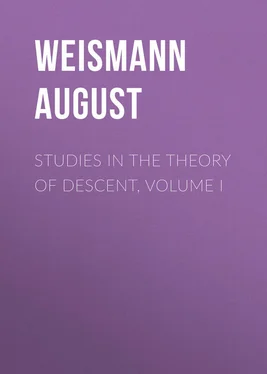August Weismann - Studies in the Theory of Descent, Volume I
Здесь есть возможность читать онлайн «August Weismann - Studies in the Theory of Descent, Volume I» — ознакомительный отрывок электронной книги совершенно бесплатно, а после прочтения отрывка купить полную версию. В некоторых случаях можно слушать аудио, скачать через торрент в формате fb2 и присутствует краткое содержание. Жанр: foreign_antique, foreign_prose, на английском языке. Описание произведения, (предисловие) а так же отзывы посетителей доступны на портале библиотеки ЛибКат.
- Название:Studies in the Theory of Descent, Volume I
- Автор:
- Жанр:
- Год:неизвестен
- ISBN:нет данных
- Рейтинг книги:4 / 5. Голосов: 1
-
Избранное:Добавить в избранное
- Отзывы:
-
Ваша оценка:
- 80
- 1
- 2
- 3
- 4
- 5
Studies in the Theory of Descent, Volume I: краткое содержание, описание и аннотация
Предлагаем к чтению аннотацию, описание, краткое содержание или предисловие (зависит от того, что написал сам автор книги «Studies in the Theory of Descent, Volume I»). Если вы не нашли необходимую информацию о книге — напишите в комментариях, мы постараемся отыскать её.
Studies in the Theory of Descent, Volume I — читать онлайн ознакомительный отрывок
Ниже представлен текст книги, разбитый по страницам. Система сохранения места последней прочитанной страницы, позволяет с удобством читать онлайн бесплатно книгу «Studies in the Theory of Descent, Volume I», без необходимости каждый раз заново искать на чём Вы остановились. Поставьте закладку, и сможете в любой момент перейти на страницу, на которой закончили чтение.
Интервал:
Закладка:
V. On Alternation of Generations
Seasonal dimorphism has already been designated by Wallace as alternation of generation, 37a term which cannot be disputed so long as it is confined to a regular alternation of dissimilar generations. But little is gained by this definition, however, unless it can be proved that both phenomena are due to similar causes, and that they are consequently brought about by analogous processes. The causes of alternation of generation have, until the present time, been scarcely investigated, owing to the want of material. Haeckel alone has quite recently subjected these complicated phenomena generally to a searching investigation, and has arrived at the conclusion that the various forms of metagenesis can be arranged in two series. He distinguishes a progressive and a retrogressive series, comprising under the former those species “which, to a certain extent, are still in a transition stage from monogenesis to amphigenesis (asexual to sexual propagation), and the early progenitors of which, therefore, never exclusively propagated themselves sexually” ( Trematoda , Hydromedusæ ). Under the other, or retrogressive form of metagenesis, Haeckel includes a “return from amphigenesis to monogenesis,” this being the case with all those species which now manifest a regular alternation from amphigenesis to parthenogenesis ( Aphides , Rotatoria , Daphniidæ , Phyllopoda , &c.). Essentially I can but agree entirely with Haeckel. Simply regarding the phenomena of alternation of generation as at present known, it appears to me to be readily admissible that these multiform modes of propagation must have originated in at least two different ways, which can be aptly formulated in the manner suggested by Haeckel.
I will, however, venture to adopt a somewhat different mode of conception, and regard the manner of propagation (whether sexual or asexual) not as the determining, but only as the secondary cause. I will further hazard the separation of the phenomena of alternating generations (in their widest sense) into two main groups according to their origin, designating the cases of one group as true metagenesis and those of the other as heterogenesis. 38Metagenesis takes its origin from a phyletic series of dissimilar forms, whilst heterogenesis originates from a phyletic series of similar forms – this series, so far as we can at present judge, always consisting of similar sexual generations. The former would thus nearly coincide with Haeckel’s progressive, and the latter with his retrogressive metagenesis. Metagenesis may further originate in various ways. In the first place, from metamorphosis, as for example, in the propagation of the celebrated Cecidomyia with nursing larvæ. The power which these larvæ possess of propagating themselves asexually has evidently been acquired as a secondary character, as appears from the fact that there are many species of the same genus the larvæ of which do not nurse, these larvæ being themselves undoubted secondary forms produced by the adaptation of this stage of phyletic development to a mode of life widely different from that of the later stages. In the form now possessed by these larvæ they could never have represented the final stage of their ontogeny, neither could they have formerly possessed the power of sexual propagation. The conclusion seems inevitable that metagenesis has here proceeded from metamorphosis; that is to say, one stage of the ontogeny, by acquiring asexual propagation, has changed the originally existing metamorphosis into metagenesis.
Lubbock 39is undoubtedly correct when, for cases like that just mentioned, he attempts to derive alternation of generations from metamorphosis. But if we exclude heterogenesis there still remain a large number of cases of true metagenesis which cannot be explained from this point of view.
It must be admitted, with Haeckel, that the alternation of generations in the Hydromedusæ and Trematoda does not depend, as in the case of Cecidomyia , upon the larvæ having acquired the power of nursing, but that the inferior stages of these species always possessed this power which they now only preserve. The nursing Trematode larvæ now existing may possibly have been formerly able to propagate themselves also sexually, this mode of propagation having at the present time been transferred to a later phyletic stage. In this case, therefore, metagenesis was not properly produced by metamorphosis, but arose therefrom in the course of the phyletic development, the earlier phyletic stages abandoning the power of sexual reproduction, and preserving the asexual mode of propagation. A third way in which metagenesis might originate is through polymorphosis. When the latter is combined with asexual reproduction, as is especially the case with the Hydrozoa, metagenesis may be derived therefrom. The successive stages of transformation of one and the same physiological individual do not in these cases serve as the point of departure for alternation of generation, but the different contemporary forms living gregariously into which the species has become divided through functional differentiation of the various individuals of the same stock. Individuals are here produced which alone acquire the power of sexual reproduction, and metagenesis is thus brought about, these individuals detaching themselves from the stock on which they originated, while the rest of the individuals remain in combination, and retain the asexual mode of propagation. No sharp distinction can be otherwise drawn between this and the cases previously considered. 40The difference consists only in the whole cycle of reproduction being performed by one stock; both classes have the common character that the different phyletic stages never appear in the same individual (metamorphosis), but in the course of further phyletic development metagenesis at the same time arises, i.e. the division of these stages among a succession of individuals. We are therefore able to distinguish this primary metagenesis from the secondary metagenesis arising from metamorphosis.
It is not here my intention to enter into the ultimate causes of metagenesis; in this subject we should only be able to advance by making vague hypotheses. The phenomenon of seasonal dimorphism, with which this work has mainly to deal, is evidently far removed from metagenesis, and it was to make this clear that the foregoing observations were brought forward. The characters common in the origin of metagenesis are to be found, according to the views previously set forth, in the facts that here the faculty of asexual and of sexual reproduction is always distributed among several phyletic stages of development which succeed each other in an ascending series (progressive metagenesis of Haeckel), whereas I find differences only in the fact that the power of asexual propagation may (in metagenesis) be either newly acquired (larva of Cecidomyia ) or preserved from previous ages ( Hydroida ). It seems that in this process sexual reproduction is without exception lost by the earlier, and remains confined solely to the most recent stages.
From the investigations on seasonal dimorphism it appears that a cycle of generations can arise in an entirely different way. In this case a series of generations originally alike are made dissimilar by external influences. This appears to me of the greatest importance, since seasonal dimorphism is without doubt closely related to that mode of reproduction which has hitherto been exclusively designated as heterogenesis, and a knowledge of its mode of origination must therefore throw light on the nature and origin of heterogenesis in general.
In seasonal dimorphism, as I have attempted to show, it is the direct action of climate, and indeed chiefly that of temperature, which brings about the change in some of the generations. Since these generations have been exposed to the alternating influence of the summer and winter temperature a periodical dimorphism has been developed – a regular cycle of dissimilar generations. It has already been asserted that the consecutive generations of a species comport themselves with respect to heredity in a manner precisely similar to that of the ontogenetic stages, and at the same time such succeeding generations point out the parallelism between metamorphosis and heterogenesis. If influences capable of directly or indirectly producing changes operate on any particular stage of development, these changes are always transmitted to the same stage. Upon this metamorphosis depends. In a precisely similar manner changes which operated periodically on certain generations (1, 3, 5, for instance) are transmitted to these generations only, and not to the intermediate ones. Upon this depends heterogenesis. We have just been led to the comprehension of heterogenesis by cyclical heredity, by the fact that a cycle is produced whenever a series of generations exists under regularly alternating influences. In this cycle newly acquired changes, however minute in character at first, are only transmitted to a later, and not to the succeeding generation, appearing only in the one corresponding, i.e. in that generation which exists under similar transforming influences. Nothing can more clearly show the extreme importance which the conditions of life must have upon the formation and further development of species than this fact. At the same time nothing shows better that the action of these conditions is not suddenly and violently exerted, but that it rather takes place by small and slow operations. In these cases the long-continued accumulation of imperceptibly small variations proves to be the magic means by which the forms of the organic world are so powerfully moulded. By the application of even the greatest warmth nobody would be able to change the winter form of A. Levana into the summer form; nevertheless, the summer warmth, acting regularly on the second and third generations of the year, has, in the course of a lengthened period, stamped these two generations with a new form without the first generation being thereby changed. In the same region two different climatic varieties have been produced (just as in the majority of cases climatic varieties occur only in separate regions) which alternate with each other, and thus give rise to a cycle of which each generation propagates itself sexually.
Читать дальшеИнтервал:
Закладка:
Похожие книги на «Studies in the Theory of Descent, Volume I»
Представляем Вашему вниманию похожие книги на «Studies in the Theory of Descent, Volume I» списком для выбора. Мы отобрали схожую по названию и смыслу литературу в надежде предоставить читателям больше вариантов отыскать новые, интересные, ещё непрочитанные произведения.
Обсуждение, отзывы о книге «Studies in the Theory of Descent, Volume I» и просто собственные мнения читателей. Оставьте ваши комментарии, напишите, что Вы думаете о произведении, его смысле или главных героях. Укажите что конкретно понравилось, а что нет, и почему Вы так считаете.












